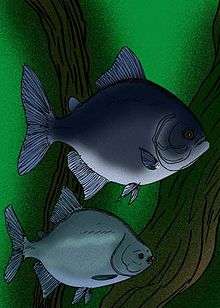Megapiranha
Megapiranha is an extinct serrasalmid characin fish from the Late Miocene (8–10 million years ago) Ituzaingó Formation of Argentina, described in 2009.[1] The type species is M. paranensis.[2] It is thought to have been about 71 centimetres (28 in) in length and 10 kilograms (22 lb) in weight.[3] The holotype consists only of premaxillae and a zigzag tooth row; the rest of its body is unknown.[4] This dentition is reminiscent of both the double-row seen in pacus, and the single row seen in the teeth of modern piranhas, suggesting that M. paranensis is a transitional form. Its bite force is estimated between 1,240–4,749 N (279–1,068 lbf).[3]
| Megapiranha | |
|---|---|
 | |
| Comparison of M. paranensis and the tambaqui | |
| Scientific classification | |
| Kingdom: | |
| Phylum: | |
| Class: | |
| Order: | |
| Family: | |
| Genus: | †Megapiranha Cione et al. 2009 |
| Species: | †M. paranensis |
| Binomial name | |
| Megapiranha paranensis Cione et al. 2009 | |
References
- Live Science: Toothy 3-foot Piranha Fossil Found
- Megapiranha at Fossilworks.org
- Grubich, J.R.; Huskey, S.; Crofts, S.; Orti, G.; Porto, J. (2012). "Mega-Bites: Extreme jaw forces of living and extinct piranhas (Serrasalmidae)". Scientific Reports. 2: 1009. doi:10.1038/srep01009. PMC 3526859. PMID 23259047.
- Cione, Alberto Luis; Dahdul, Wasila M.; Lundberg, John G.; Machado-Allison, Antonio (2009). "Megapiranha paranensis, a new genus and species of Serrasalmidae (Characiformes, Teleostei) from the Upper Miocene of Argentina". Journal of Vertebrate Paleontology. 29 (2): 350. doi:10.1671/039.029.0221. (Summary of the paper).
This article is issued from Wikipedia. The text is licensed under Creative Commons - Attribution - Sharealike. Additional terms may apply for the media files.